BASIC PRINCIPLES OF VENTILATION IN THE INTENSIVE CARE


BASIC PRINCIPLES OF VENTILATION IN THE INTENSIVE CARE UNIT Maury Shapiro Department of Intensive Care Rabin Medical Center Beilinson Campus

TYPES OF RESPIRATORY FAILURE HYPOXIC ABNORMALITIES OF OXYGENATION HYPERCAPNIC ALVEOLAR HYPOVENTILATION INCREASED DEAD SPACE(VD) EXCESSIVE CO2 PRODUCTION COMBINED

TREATMENT OF OF RESPIRATORY FAILURE TREAT CAUSE HYPOXIC RESPIRATORY FAILURE OXYGEN PEEP / CPAP HYPERCAPNIC RESPIRATORY FAILURE VENTILATE ADJUNCT THERAPY OPTIMAL FLUID BALANCE NUTRITION BRONCHODILATOR THERAPY PHYSIOTHERAPY PRONE POSITION Nitric Oxide etc.

INDICATIONS FOR MECHANICAL VENTILATION Acute Respiratory Failure (66%) ARDS Heart failure Pneumonia Sepsis Complications of surgery Trauma Coma (15%) Acute COPD exacerbation (13%) Neuromuscular disorders (5%) Esterban Am J Respir Crit Care Med 2000

COMPLICATIONS OF VENTILATION ENDOTRACHEAL TUBE COMPLICATIONS Tube not in place Oropharynx or esophagus One lung intubation Tube blocked Cuff air leak VENTILATOR FAILURE Machine failure Alarm failure Alarms off Inadequately set alarms

COMPLICATIONS OF VENTILATION MEDICAL COMPLICATIONS Oxygen toxicity Barotrauma Pneumothorax Pneumomediastinum Parenchymal interstitial emphysemia Volutrauma Biotrauma Atelectasis Infection Hypoventilation Hyperventilation Hypotension GI hypomotility Stress gastropathy Arrhythmias Salt + water retention Gastric dilatation
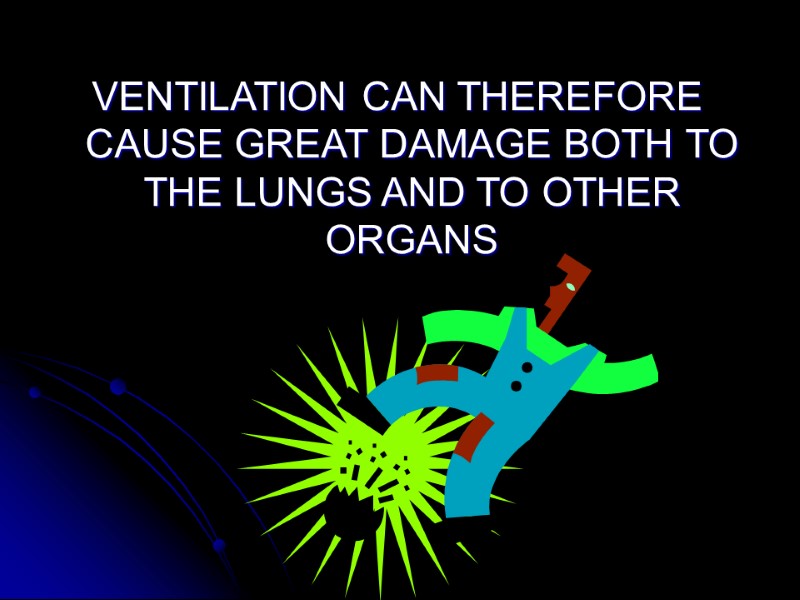
VENTILATION CAN THEREFORE CAUSE GREAT DAMAGE BOTH TO THE LUNGS AND TO OTHER ORGANS

HOW TO AVOID THESE PITFALLS Personnel should have basic understanding of ventilators and ventilatory principles. Understand the safe limits of ventilation Lowest FIO2 and PEEP to maintain oxygen saturation > 90% Maintain plateau pressure < 35cmH2O Maintain sterile techniques

VENTILATION POSITIVE PRESSURE VENTILATION NEGATIVE PRESSURE VENTILATION NON INVASIVE VENTILATION INVASIVE VENTILATION CONVENTIONAL VENTILATION NON CONVENTIONAL VENTILATION High frequency jet High frequency oscillations Liquid ventilation APRV

Negative pressure ventilation Non invasive ventilation Invasive ventilation

INVASIVE VENTILATION Ventilators = Husband Have to tell it exactly what to do. Sometimes it malfunctions therefore require warnings and backup.

Ventilators can measure 4 parameters TIME PRESSURE FLOW VOLUME We can use these parameters to tell the ventilator when to start pushing air/oxygen into patient and when to stop.

Ventilators need to know 5 basic things: The amount of oxygen to provide – FIO2 What is the baseline pressure PEEP When to start pushing air/O2 into patient TRIGGER How quickly to push the air/O2 in LIMIT When to stop pushing air/O2 in CYCLE
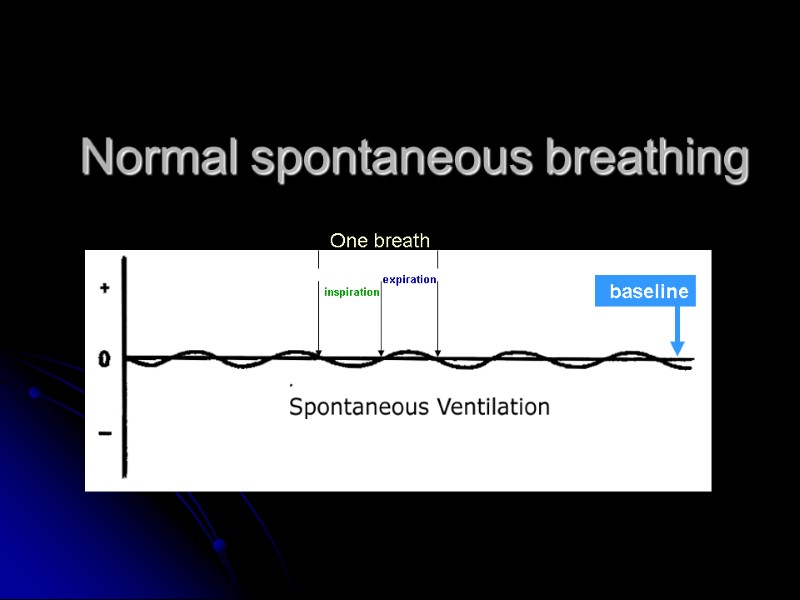
Normal spontaneous breathing baseline inspiration expiration One breath

TIME INSPIRATION EXPIRATION Ventilator breath Start inspiration End inspiration Start next breath

TRIGGER BASELINE CYCLE BASELINE LIMIT TIME INSPIRATION EXPIRATION

TRIGGER Time – RATE or Pressure or flow BASELINE PEEP ZEEP NEEP CYCLE Volume or Time or Flow BASELINE PEEP,ZEEP,NEEP LIMIT Flow or Pressure INSPIRATION EXPIRATION TIME

MODE OF VENTILATION DETERMINED BY LIMIT AND CYCLE Pressure Limited Flow Cycled PRESSURE SUPPORT VENTILATION Flow Limited Volume Cycled VOLUME CONTROLLED VENTILATION Pressure Limited Time Cycled PRESSURE CONTROLLED VENTILATION

Pressure Limited Flow Cycled Ventilation (PSV) -operator selects FIO2, pressure, PEEP Operator chooses Factory determined

Pressure Limited Time Cycled Ventilation (PCV) -operator selects FIO2, pressure, insp time (I:E ratio), rate, PEEP Operator chooses

Flow Limited Volume Cycled Ventilation (VCV) -operator selects FIO2, flow, tidal volume, rate, PEEP Operator chooses Operator chooses Flow 45L/min

Pressure- limited, flow-cycled ventilation (PSV) ADVANTAGES improved patient comfort patient controls initiation of ventilator supported breath patient partially controls cessation of ventilator supported breath DISADVANTAGES no back up

PRESSURE LIMITED TIME CYCLED(PCV) ADVANTAGES ? less barotrauma improved patient comfort DISADVANTAGES minute volume not guaranteed

FLOW LIMITED VOLUME CYCLED(VCV) ADVANTAGES ensures minute volume easy to use DISADVANTAGES may result in high inspiratory pressures barotrauma may be uncomfortable to patient flow limit

IF CHOOSE VCV OR PCV must make additional choice - the character of additional spontaneous breaths Controlled Mechanical Ventilation CMV Assist Controlled Ventilation A/C Synchronized Intermittent Mandatory Ventilation SIMV

Pressure Limited Time Cycled Ventilation (PCV) CONTROLLED MECHANICAL VENTILATION(CMV) -operator selects FIO2, pressure, insp time (I:E ratio),rate, PEEP Operator chooses
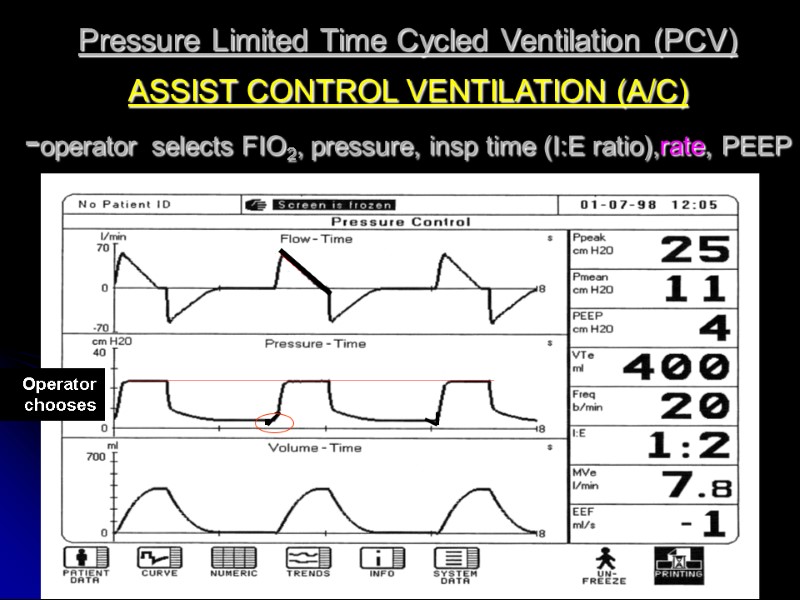
Pressure Limited Time Cycled Ventilation (PCV) ASSIST CONTROL VENTILATION (A/C) -operator selects FIO2, pressure, insp time (I:E ratio),rate, PEEP Operator chooses

Flow Limited Volume Cycled Ventilation SYNCHRONIZED INTERMIITENT MANDATORY VENTILATION (SIMV) -operator selects FIO2, flow, tidal volume, rate, PEEP

Mode pressure flow volume Ti rate other alarms PSV yes volume- max & min PCV yes yes yes CMV;A/C;SIMV volume-min & max VCV yes yes yes CMV;A/C;SIMV pressure PSV or PCV or VCV must set 1) FIO2 2)PEEP 3)trigger:pressure or flow The secret to a happy operator-ventilator relationship is to understand the abilities of the ventilator. What must I set on the ventilator?

MONITORING Ventilator-patient synchrony Saturation > 90% PaCO2 Normal only if does not require high pressure Peak pressure < 35cmH2O Tidal volume 5 – 7cc/kg Rate 8 -30 breaths/min

ALARMS OXYGEN PRESSURE Max 35cmH2O Min 10cmH2O Tidal volume Max 7cc/kg Min 3cc/kg Rate Max 30 breaths/min Min 8 breaths/min BACK UP Apnea time Apnea parameters

SUMMARY TYPES OF RESPIRATORY FAILURE HYPOXIC HYPERCAPNIC COMBINED

SUMMARY TREATMENT OF RESP. FAILURE ALWAYS TREAT CAUSE

SUMMARY TREATMENT OF HYPOXIC RESP. FAILURE OXYGEN CPAP / PEEP
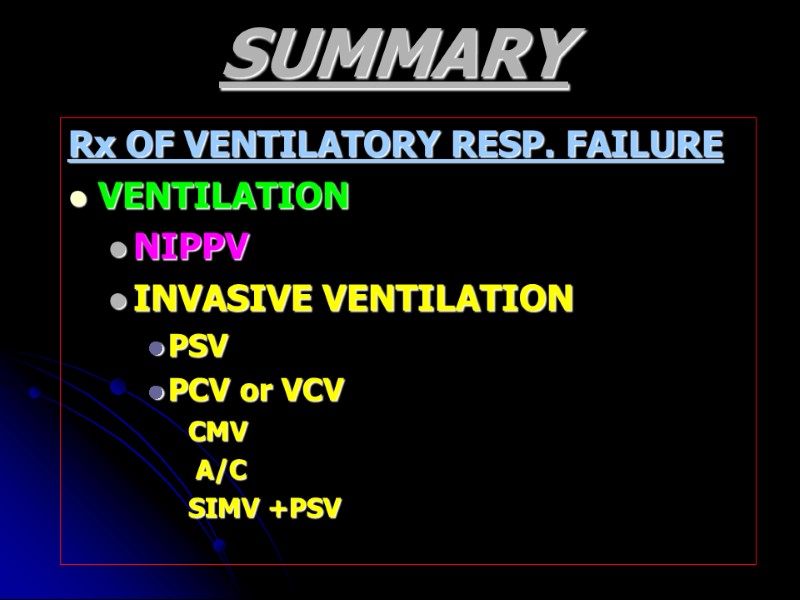
SUMMARY Rx OF VENTILATORY RESP. FAILURE VENTILATION NIPPV INVASIVE VENTILATION PSV PCV or VCV CMV A/C SIMV +PSV

SUMMARY All ventilated patients need intensive monitoring for: improvement synchrony between patient and ventilator complications
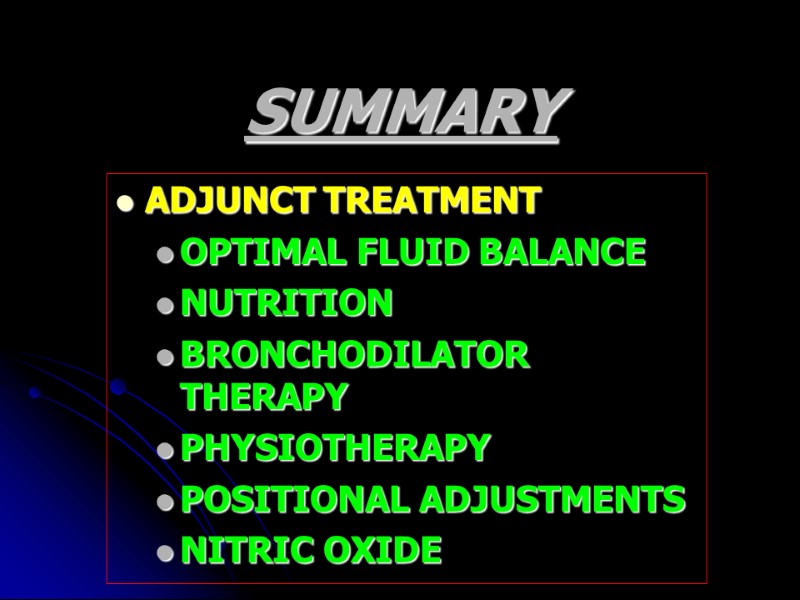
SUMMARY ADJUNCT TREATMENT OPTIMAL FLUID BALANCE NUTRITION BRONCHODILATOR THERAPY PHYSIOTHERAPY POSITIONAL ADJUSTMENTS NITRIC OXIDE

16770-ventilation_university.ppt
- Количество слайдов: 38

